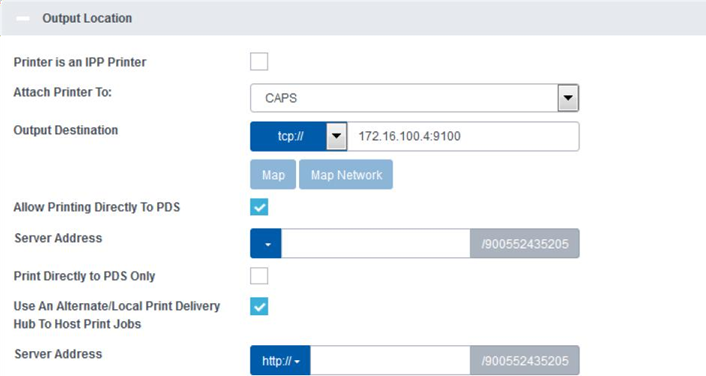Configuring the printer’s network location
The Output Location settings allow you to specify the network location of the physical printer to which this PrinterOn printer definition is mapped, and to define how the server delivers print jobs to this printer (for example, directly, via a PDS, or via a PDH). You can also specify whether the printer is an IPP printer that bypasses the PDS.

📘 Instructions
Output Location settings:
Configuring the printer’s network location | Printer-is-an-IPP-Printer
Configuring the printer’s network location | Printer-Address
Configuring the printer’s network location | Attach-Printer-To
Configuring the printer’s network location | Output-Destination
Configuring the printer’s network location | Allow-Printing-Directly-to-PDS
Configuring the printer’s network location | Print-Directly-to-PDS-Only
Configuring the printer’s network location | Server-Address.1
Printer is an IPP Printer
When checked, indicates that the printer supports the IPP protocol. When you enable this setting, the remaining settings change to simplify the configuration.
Note: When Printer is an IPP printer is enabled, the remaining Output Location settings are disabled and set to Direct Printing Only, which indicates that jobs are sent directly to the printer. This setting is not configurable.
Printer Address
The IP address and port for an IPP printer.
Note: This field is only displayed only when Printer is an IPP Printer is enabled.
Attach Printer To
Links the printer with a Print Delivery Station. This field is only displayed when Printer is an IPP Printer is disabled.
Note: You can also configure this setting for printers with an embedded PDS in the Link Printers dialog. For more information, see Linking printers with a Print Delivery Station.
Output Destination
Defines the physical printer, print queue, or file to which the PrinterOn printer is mapped. You must define the Output Destination value to provide the target to which the PrinterOn Server directs all print jobs sent to the selected PrinterOn printer.
For detailed information about defining the output destination, see Configuring Printer Output Destinations.
Allow Printing Directly to PDS
When checked, indicates that print jobs are sent to the PDS server.
Note: Only select this option if the PDS is accessible from the main server. In some cases, print jobs can only be delivered to a PDS using an intermediate Print Delivery Hub (PDH).
Server Address
The fully qualified network address of the Print Delivery Station server that manages this printer. Select a scheme to indicate whether SSL will be used. Often, this is simply the address of the local server.
Indicating an explicit port along with the server address can improve print performance. The server automatically uses the specified port, if provided. Otherwise, it scans ports 80, 443, and 631, as well as SSL and non-SSL connections, which can slow delivery.
Note: This field is only displayed when Allow Printing Directly to PDS is selected.
Print Directly to PDS Only
When checked, all print jobs are printed directly to the PDS and are not sent to a PDH. This setting only applies if a PDH is available. In most cases, you should enable this setting.
Use an Alternate/Local Print Delivery Hub to Host Print Jobs
When checked, indicates that a Print Delivery Hub server is available for printing. This option should be specified if a PDS is accessible directly by the server. In some cases, this option may be used if multiple PDS servers are deployed for the same printer, for redundancy.
Configuring both a PDS and PDH server can assist desktop printing using PrintWhere for roaming users who may move between networks regularly and cannot always contact PDS.
Server Address
The fully qualified network address of the Print Delivery Hub server. Select a scheme to indicate whether SSL will be used.
Indicating an explicit port along with the server address can improve print performance. The server automatically uses the specified port, if provided. Otherwise, it scans ports 80, 443, and 631, as well as SSL and non-SSL connections, which can slow delivery.
Note: This field is only displayed when Use an Alternate/Local Print Delivery Hub to Host Print Jobs is selected.
